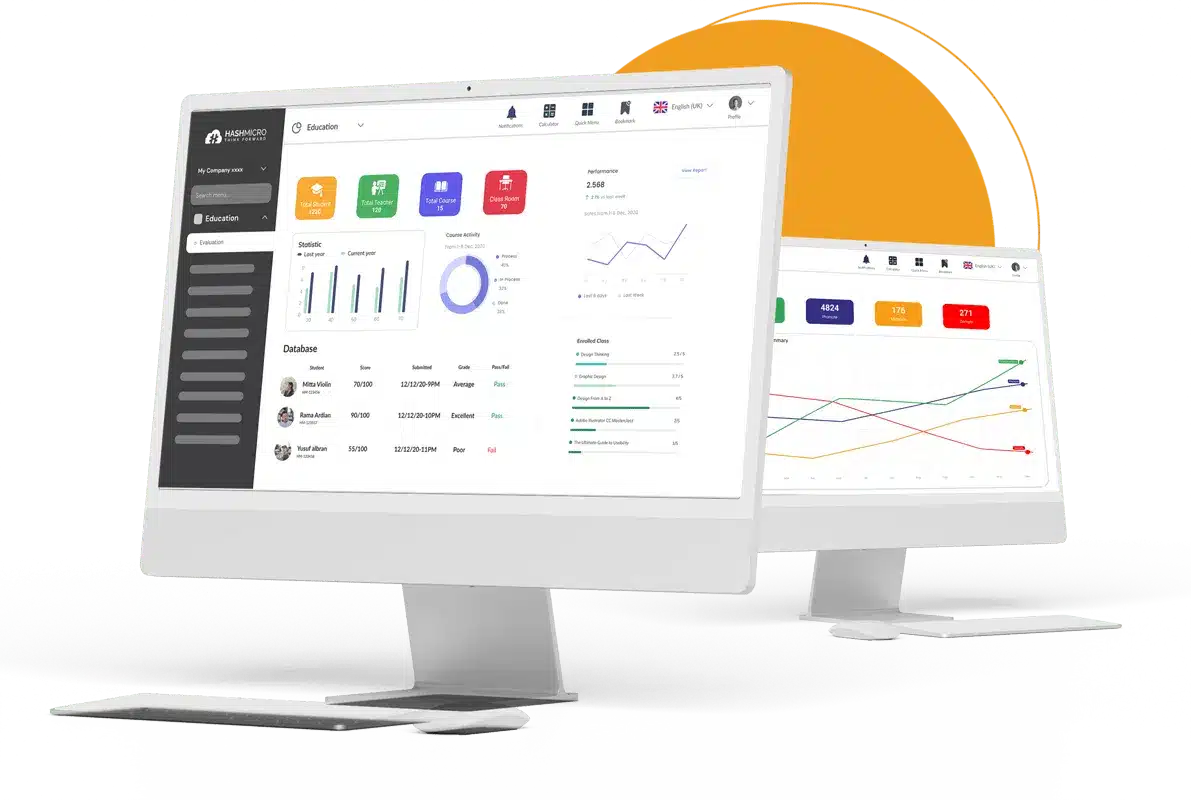ERP Solutions for Schools help me manage daily school operations more efficiently by integrating all departments into a single platform. From student records to finance and transportation, everything is centralized to eliminate duplicate data.
With the school management system, I can access real-time dashboards from anywhere, at any time. Teachers can easily track student progress, while parents stay informed about their child’s development, creating stronger communication between home and school.
The system is fully customizable to meet the needs of every institution, enhancing both efficiency and transparency. Explore the ERP Solutions for School pricing scheme or request a free demo from HashMicro today!
Key Takeaways
|
Why Implementing ERP Solutions for Schools is Essential
Many functions, processes, and operations take place behind the scenes at my school, all working together to keep everything running smoothly. However, I’ve noticed that these tasks are often time-consuming and costly, which reduces overall productivity.
ERP Solutions for Schools automate key processes, helping administrators, teachers, students, and parents work more efficiently. It streamlines tasks, enhances communication, and improves overall convenience for all stakeholders.
How to Choose the Best ERP for Schools

If you want to implement the best ERP system for your school, you need to understand the key aspects to maximize its benefits for your operations. Here are the key elements to help you choose the best ERP for your school:
1. Know your specific school needs
To select the most suitable ERP system for schools, it’s essential first to identify the institution’s specific needs. This involves thoroughly assessing existing processes such as student data management, financial operations, scheduling, and academic support.
By understanding the unique challenges and requirements of each department, schools can choose an ERP solution equipped with the right features to enhance efficiency and streamline overall management.
2. Search for an ERP that has useful features
The ideal ERP system for schools should provide comprehensive functionalities that address every operational need. Below are the core features an effective school ERP should include:
- Student management: This module enables schools to handle student databases efficiently, including profiles, course enrollments, and academic performance. It also helps track tuition payments and pending learning materials.
- Human resource management: An ERP system simplifies staff administration by centralizing teacher and employee data such as personal information, salary details, and performance records.
- Enrollment management: With an ERP, schools and training centres can automate and streamline the admission process, from online applications and document verification to candidate selection and final enrollment.
- Course management: Educators and administrators can easily create, organize, and update course content and schedules. The system also supports monitoring of teaching quality through assignments and study materials.
- Financial management: The ERP platform enhances financial transparency by managing income, expenses, invoices, tuition collection, and budget reports in one place.
- Library management: With this feature, schools can efficiently catalogue and monitor library resources. Administrators can oversee book inventories and track borrowing activities.
3. Customization and scalability
Every educational institution operates differently, with its own workflows and priorities. Therefore, the ideal ERP system for schools should offer flexible customization options that align with each institution’s specific needs.
Below are several areas where customization can enhance performance and usability:
- Adapting management processes: The ERP system should allow modules to be tailored according to existing workflows. Customizing these processes ensures the software effectively supports the daily operations of both staff and teachers.
- Personalizing the user interface: A school ERP should feature an intuitive and user-friendly interface that caters to diverse users, including administrators, teachers, and students.
- Enabling continuous adjustments and feedback: An effective ERP system should provide flexibility for ongoing modifications and updates without interrupting daily activities.
4. Integration
When selecting the best ERP for schools, it’s essential to consider how well the software can integrate with existing systems such as learning management systems (LMS), HR software, and accounting platforms.
By synchronizing information across multiple systems, schools can eliminate duplicate entries and reduce errors. This not only keeps data accurate and up to date but also supports faster, more informed decision-making for administrators and staff.
5. Cost
When selecting an ERP system for schools, it’s essential to evaluate the overall costs involved. Below are the two main types of expenses to consider:
- Initial implementation costs: These include expenses for software licensing, system installation, and staff training. Optimizing for a user-friendly and feature-rich ERP can reduce long-term operational costs by minimizing the need for extensive support.
- Maintenance and upgrade costs: To keep the system secure and efficient, regular maintenance and updates are essential. These costs typically cover technical support, software version upgrades, and the addition of customized features.
Here is a table summary about key elements to help you choose the best ERP for your school
| Key Elements | Description |
| Know your specific school needs | Start by identifying your school’s unique operational requirements. Assess current processes like student management and scheduling to find areas that need improvement. |
| Search for an ERP that has useful features | Choose software that offers essential tools such as student, HR, finance, and course management. A feature-rich ERP simplifies workflows and boosts overall efficiency. |
| Customization and scalability | Select an ERP system that can adapt to your school’s specific structure and grow with its needs. Customizable modules and flexible interfaces ensure smooth daily operations. |
| Integration | Ensure the ERP integrates seamlessly with existing systems like LMS, HR, and accounting software. Strong integration enhances real-time decision-making. |
| Cost | Evaluate both initial setup and long-term maintenance costs. Investing in a user-friendly, scalable ERP reduces support expenses and delivers better value over time. |
10 Benefits of Implementing ERP Solutions for Schools
Implementing an ERP system helps schools streamline operations, enhance communication, and improve overall efficiency. With integrated processes, institutions can focus more on delivering quality education and better support for students and staff.
1. Enhances teaching quality
When I had to adapt to online teaching, it was challenging to keep students engaged through a screen. With ERP Solutions for Schools, I can now design creative lessons, conduct smart classroom sessions, and share video tutorials for students to access anytime.
Through the homework management feature, I can easily distribute assignments and receive submissions in one place. The task management tool also helps me stay organized and efficient, making my teaching process more productive and enjoyable.
2. Improves overall productivity
ERP Solutions for Schools offer features such as student and employee management, fee tracking, and account administration, all within a single, paperless system. I can also manage inventory and notifications efficiently, helping my school improve productivity.
The system automates the entire admissions process, from collecting online forms to communicating with parents, saving me valuable time. It also streamlines fee payments and other key operations, allowing me to focus on improving overall school performance.
Also read: The Best Education ERP Systems for Your School
3. Provides more learning flexibility
With ERP Solutions for Schools, my students can easily access video tutorials, join online classes, and track their homework. These features ensure they never miss a lesson and can learn comfortably at their own pace, even through their parents’ smartphones.
Students can also download materials and watch lectures offline whenever needed. This flexibility helps them understand each topic deeply without feeling pressured to rush for grades.
4. Provides greater transparency
ERP Solutions for Schools offer valuable integrations, such as payment gateways and WhatsApp Messenger. With WhatsApp integration, I can easily send fee reminders, event updates, and student progress reports directly to parents’ smartphones.
The payment gateway integration enables parents to pay fees digitally using their preferred method, including wallets, internet banking, or cards. It eliminates the need for cash transactions and builds greater trust between parents and the school.
Also Read: Best ERP Software Recommendations – Explore the best software options available this year and find the right fit for your business needs.
5. Streamlined administrative operations
ERP Solutions for Schools centralize all administrative tasks, such as admissions, attendance, and fee management, into one integrated platform. This eliminates redundant manual work, reducing errors and saving valuable time.
By automating repetitive processes, I can focus more on strategic decisions rather than spending time on paperwork. It also ensures data accuracy and improves coordination between different school departments.
6. Improved communication between stakeholders
With ERP software, I can communicate more efficiently with teachers, parents, and students through one unified system. Notifications, reports, and updates can be sent instantly through integrated channels, such as WhatsApp or email.
This helps me ensure that everyone stays informed about academic progress and school activities in real time. Better communication also enhances collaboration and builds stronger relationships across the school community.
7. Scalability and customization
ERP Solutions for Schools can be tailored to suit the size and needs of any educational institution. Whether managing a single campus or multiple branches, the system scales easily.
I can customize modules such as HR, finance, or student management according to my school’s requirements. This flexibility ensures long-term usability as the institution continues to grow and evolve.
8. Better attendance tracking
With biometric or RFID integration, I can record attendance automatically for both students and staff. This eliminates manual entry errors and ensures I always have real-time attendance reports at my fingertips.
I can easily monitor absences and punctuality trends without wasting time on manual logs. Parents also receive automatic updates about their child’s daily attendance, keeping everyone informed and connected.
9. Efficient fee and financial management
With the ERP system, I can automate fee collection, invoice generation, and payment tracking seamlessly. Parents can conveniently pay fees online using bank transfers, credit cards, or e-wallets.
This setup minimizes human error and significantly reduces my administrative workload. I can also generate financial reports instantly, providing me with clear insight into my school’s cash flow and overall financial health.
10. Real-time insights and analytics
With ERP software, I can access data-driven insights through interactive dashboards and detailed reports. These analytics help me evaluate performance trends, monitor resource utilization, and plan improvements more effectively.
Having real-time data at my fingertips enables me to respond quickly to issues such as low attendance or declining academic performance. It empowers me to make informed, evidence-based decisions that drive continuous improvement in my school.
“ERP solutions for schools streamline every academic and administrative process, from admissions to finance, by integrating all departments into one intelligent system. This allows educators to focus more on student growth rather than paperwork.”
— Angela Tan, Regional Manager
Streamline Your School Operations with HashMicro’s School Management Software

HashMicro’s School Management Software offers an all-in-one solution to simplify and automate school operations. The system enables educational institutions to manage academic, financial, and administrative processes efficiently.
The software provides high flexibility, allowing schools to customize workflows that align with their structure and needs. With its powerful automation features, schools can build a more efficient system for reporting, communication, and performance monitoring.
Here are the key features of HashMicro’s School Management Software that help enhance operational efficiency:
- Automated Attendance Tracking: Record student and staff attendance instantly with digital tools that ensure accuracy and save time.
- Online Admission Management: Streamline the enrollment process with automated application tracking, document verification, and student data management.
- Integrated Finance Management: Handle tuition payments, budgeting, and expense tracking in real time for transparent financial reporting.
- Course and Schedule Management: Easily create, update, and monitor class schedules and course materials across departments.
- Library and Asset Management: Manage school resources and monitor borrowed materials efficiently.
Conclusion
To keep my school performing at its best, I need reliable tools and systems that simplify daily operations and improve efficiency for both staff and students. Adopting the right technology helps enhance the overall learning experience.
With HashMicro’s School Management Software, I can efficiently manage online classes, remote teaching, cashless payments, online admissions, and digital records. The system also supports contactless attendance and various automation features.
If you are yet to implement it in your school, contact us to get a free demo of School Management Software and see how it can be helpful for you and others at your school. As Singapore’s number 1 ERP software provider, we will help with all your business needs.

FAQ About ERP Solutions for School
-
What does ERP mean in a school setting?
An ERP (Enterprise Resource Planning) system in schools is designed to simplify and organize various operations by integrating them into a single platform. It connects essential functions like student management, attendance, grading, scheduling, fee collection, HR, and communication under one unified system.
-
What is the future of ERP implementation in schools?
In the post-pandemic landscape, ERP systems are becoming more adaptive and scalable, supporting hybrid learning environments. They enable seamless integration with Learning Management Systems (LMS), online payment gateways, and digital attendance tracking tools.
-
How does AI enhance modern ERP systems?
AI-driven ERP platforms automate repetitive tasks, deliver predictive analytics, and support smarter decision-making. The integration of AI enhances efficiency, streamlines workflows, and empowers schools with data-driven insights.

































